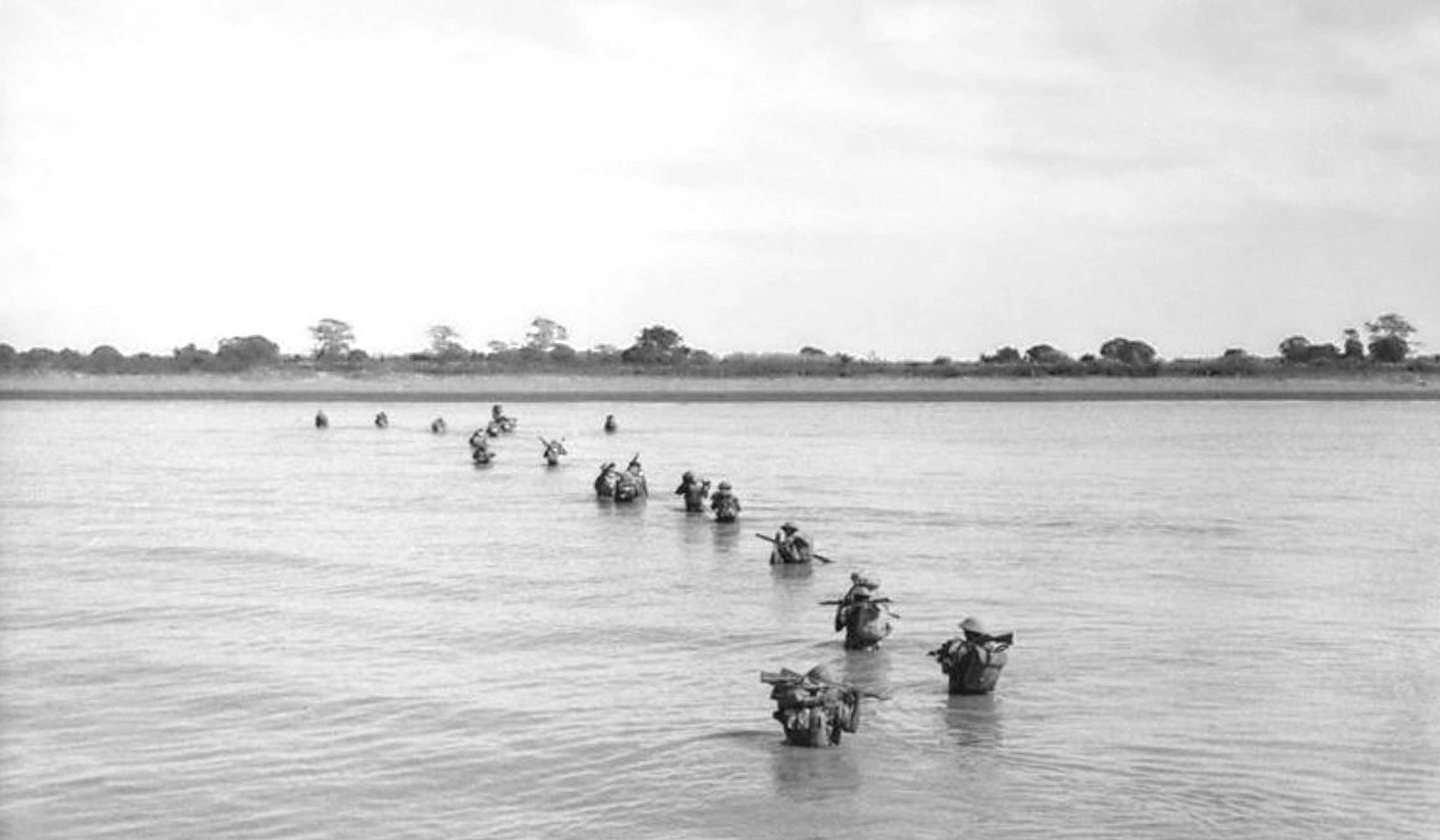At the end of February, 1945 about 1,000 surviving Japanese soldiers based on Ramree Island off the coast of Arakan, a province in western Burma, fled the onslaught of the British Army commanded by Lt General William Slim. A squadron led by the battleship HMS Queen Elizabeth had bombarded Japanese positions on Ramree. The 26th Indian Infantry Division, led by Marlborough and Sandhurst Old Boy Major-General Cyril Lomax, swept in to finish them off.
Characteristically the Japanese soldiers did not surrender. Instead, they opted to get to shore through the mangrove swamps that connected Ramree Island with the mainland. Big mistake. A Canadian soldier Bruce Wright, who is credited with developing the military art of being a frogman (a soldier trained to scuba), author of The Frogmen of Burma, described what happened next: ‘of about 1,000 Japanese soldiers that entered the swamps of Ramree, only about 20 were found alive’. They had been eaten by saltwater crocodiles. According to Wright the night was pierced by screams, gunfire and the ‘sound of spinning crocodiles’.
The Guiness Book of Records described the croc massacre as ‘The Greatest Disaster Suffered from Animals’. Except it wasn’t. Wright, sitting on a motorboat at the time, was repeating second hand stories; a classic case of Chinese whispers. Expert herpetologists have pooh-poohed the croc story. Very possibly a small number of Japanese were eaten by crocs, many possibly were already dead, but a ‘Battle of the Crocs’ it was not. More prosaically most of the 500 who died were most likely killed by their wounds, disease, dehydration and drowning in the fetid mangrove swamp.
This is not to say that crocodiles did not feature in the Pacific War. At the Battle of Guadalcanal in the Solomon Archipelago, downed Japanese pilots refused to be rescued and taken prisoner. Some even begged to be shot. No doubt some American soldiers were happy to oblige. Better that perhaps than be eaten by crocodiles who infested the islands. After the nighttime Battle of Manatiku River on the island of Guadalcanal, dawn revealed burnt out tanks and piles of bodies. They were being feasted on by crocodiles.
During the joint American-Australian campaign to establish the allied forces at Salamaua and Lae on the north of New Guinea, an American officer recalled that during a rest stop, a fellow GI was:
‘Caught and killed by a crocodile… it was over in the blink of an eye. The croc struck, spun, thrashed about and was gone, leaving a bloodstain in the water. No more bathing.’
At the Battle of Porton Plantation on the island of Bougainville, the largest island in the Solomon Archepelago, Australian pilot Jack Hearn recalled seeing soldiers,
‘hit and killed, fallen overboard and grabbed by huge sea-going saltwater crocodiles. Flying low down over the reefs, I have had crocodiles snap at the aircraft like a dog would as you pass over the top of them.’
Incidents like these were one offs. However, if readers are looking for a truly macabre and truthful ‘man versus predator’ story, then sharks and the sinking of the USS Indianapolis is the only place to go. The American cruiser was a distinguished ship having served as Admiral Raymond Spruance’s flagship at the crushing defeat of the Japanese Navy at the Battle of the Philippine Sea (commonly known as the Great Marianas Turkey Shoot). In July1945, the Japanese submarine I-58 scored two torpedo hits on the Indianapolis. The US cruiser, having dropped critical parts at Tinian Island for ‘Little Boy’, the atom bomb to be used at Hiroshima, was on its way to the Philippines. Of the 890 of the 1,195 crewmen who survived the rapid sinking, only 316 were eventually saved after days spent in the water. While soldiers died of heat exposure and dehydration, many were eaten by sharks. As one survivor recorded,
‘You know by the end of that first dawn, lost a hundred men. I don’t know how many sharks, maybe a thousand. I do know how many men, they averaged six an hour.’
It was the largest loss of life ever suffered by a US naval ship. It is a story that has passed into legend. Paul Allen, the co-founder of Microsoft with Bill Gates, even paid for an expedition to find the ship. Meanwhile in Steven Spielberg’s Jaws, the telling of the story of the US Indianapolis by actor Robert Shaw is one of the central scenes.
It was not an isolated episode. Earlier, at the Battle of Savo Island (near to Guadalcanal), the sinking of the USS Vincennes dumped a thousand men in the water. They were attacked by swarms of sharks which the rescuing ships tried to hold off with riflemen.
There was a similar episode when a cyclone, Typhoon Cobra, wrecked Admiral Halsey’s fleet after a successful attack on the Japanese airfield on Luzon, the Philippines’ main northern island. Among others USS Monaghan, a destroyer, was sunk. There were six survivors including Archie DeRyckere. As his hopes were raised by the sight of an approaching ship, he was bumped in the back of his head by a shark. He screamed to the heavens,
‘You know God, first you take my ship. Then you have me swim around the ocean all night. And now you are going to feed m to the sharks? That ain’t right.’
Then he found himself in the midst of a hail of bullets as machine gunners tried to ward off the circling sharks. He was pulled aboard… alive.
Crocodiles and sharks may be the stuff of boys’ own stories but they were not the main predator faced by soldiers during the second world war. Soldiers’ natural enemy was smaller and deadlier. The mosquito. They made the life of troops utterly miserable. Thus, a piece of doggerel verse published in the China-Burma Roundup magazine:
I am wearing of bathing with Lysol
And washing with carbolic soapI am tired of itch and spin diseases
Moquitoes and vermin and flies
I am fed up with tropical breezes
And sunshine that dazzles your eyes
To eat without fear of infection
To sleep without using a net
And throw away all my collection
Of iodine, quinine, et cet.
In New Guinea, infantryman Robert Kennington described swarms of mosquitoes that ‘were so thick you could wipe them off your arms in handfuls.’ On Munda, Sergeant Antony Coulis complained of ‘mosquitoes tormenting us at night. It was sheer physical torture.’ At New Guinea’s airfield, American ground crew would joke that the mosquitoes were so big that they tried to refuel them. Discomfort was not the main problem. Mosquitoes carried malaria, dengue and yellow fever.
For General Slim, author of Britian’s great victories in Burma in 1944 and 1945, his brilliance as a commander was in no small part due to his emphasis on logistics. The provision of good tents, mosquito nets, quinine and fresh food was paramount. Slim noted that ‘for everyman evacuated with wounds we have 120 evacuated sick.’ At the first Battle of the Arakan 90 per cent of the army’s casualties were from malaria. Health was a priority. Training was equally important. Troops were banned from taking showers after sunset when mosquitoes became more active. Officers who failed to make sure that at least 95 per cent of their troops were taking Mepacrine, were dismissed.
If mosquitoes were bad for allied troops, they were catastrophic for the poorly supplied and equipped Japanese troops in the South Pacific. On Bougainville, the largest of the Solomon Islands, Japan’s 65,000 strong garrison was whittled down to 21,000. Just 8,000 died in combat but 36,000 died of disease and starvation. By comparison only 1,243 American troops died. It was pattern for the Japanese that was repeated throughout the South Pacific. There was reason why the South Pacific was so sparsely populated.
Not all insects were naturally deadly. Unit 731 managed by General Shiro Ishii at Harbin developed fleas inflected with plague. As part of the Chinese holocaust carried out by Emperor Hirohito’s armies, canisters of infected flees were dropped on China’s civilian population during the Pacific War. At the Khabarovsk War Crimes Trials in 1949, Kawashima Kiyoshi, a medical officer of Unit 731 admitted:
‘I personally participated in an expedition to spread plague bacteria in central China… We used aircraft to scatter plague-infected fleas over the area of Nanking.’
It is estimated these flees could have killed as many as 400,000 people as part of the holocaust which killed 20 to 30 million Chinese.
Of course, there was one predatory practice which American troops hardly dared speak of: cannibalism. During the great famines that accompanied the Japanese military campaigns in China, cannibalism became a common practice. In the South Pacific, cannibalism in the Japanese Army clearly took place. The documentary, The Emperor’s Naked Army Marches On, which won the Caligari Film Award for director Kazuo Hara at the Berlin Film Festival, showed former Japanese soldiers admitting to cannibalism in New Guinea.
Sometimes they ate their own fallen colleagues but on occasions ‘white pigs’ [Australian soldiers] as well as ‘Black pigs’ [Native Papuans] were killed and eaten. Lieutenant Sakamoto admitted that, during the Battle of the Kokoda Trail in New Guinea, ‘because of the food shortages, some companies have been eating the flesh of Australian soldiers.’ A horrifying idea indeed, but not one, like crocodiles and sharks, that would be suitable for the silver screen or the Guinness Book of Records.








Comments